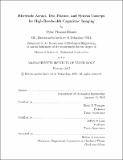Electrode arrays, test fixture, and system concept for high-bandwidth capacitive imaging
Author(s)
Hamer, Tyler Thomas.
Download986241524-MIT.pdf (8.763Mb)
Other Contributors
Massachusetts Institute of Technology. Department of Mechanical Engineering.
Advisor
David L Trumper and Jeffrey H Lang.
Terms of use
Metadata
Show full item recordAbstract
Spot defects are a leading source of failure in the fabrication of integrated circuits (ICs). Thus, the IC industry inspects for defects at multiple stages of IC fabrication, especially the fabrication of IC photomasks. However, existing non-invasive imaging methods cannot image a modern photomask in a reasonable time-frame. Electroquasistatic (EQS) sensors are arrays of electrode pairs that capacitively couple to targets they sweep over. Utilizing high measurement frequencies and a number of parallel scanning electrode pairs, EQS sensors have been suggested as a potential high speed alternative for defect detection in IC fabrication. This thesis continues the investigation into EQS sensors for high speed imaging by exploring EQS sensors driven with high excitation frequencies. We develop electrode arrays that can be driven with high excitation frequencies and construct high frequency EQS sensors by attaching them to high frequency drive electronics. We also fabricate a test fixture for positioning these sensors relative to and sweeping them across targets on a conductive base. As the sensors sweep across targets, their impedance is measured from 1 - 500 MHz using an impedance analyzer and is later converted into the capacitance between the sensor's electrode array and the target. Capacitance changes are produced by a variable air gap and by a dielectric step, confirming these sensors can detect changes in a target's geometric and material properties with high excitation frequencies. Finally, we present concepts for a high speed measurement system which utilizes these sensors.
Description
This electronic version was submitted by the student author. The certified thesis is available in the Institute Archives and Special Collections. Thesis: S.M., Massachusetts Institute of Technology, Department of Mechanical Engineering, 2017 Cataloged from PDF version of thesis. Includes bibliographical references (pages 147-151).
Date issued
2017Department
Massachusetts Institute of Technology. Department of Mechanical EngineeringPublisher
Massachusetts Institute of Technology
Keywords
Mechanical Engineering.